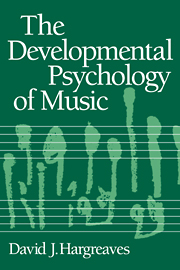Book contents
- Frontmatter
- Contents
- Preface
- 1 The developmental psychology of music
- 2 Children's thinking and musical development
- 3 Musical development in the preschooler
- 4 Musical development in the schoolchild
- 5 Development of responses to music
- 6 Creativity, personality, and musical development
- 7 Social psychology and musical development
- 8 Developmental psychology and music education
- References
- Author Index
- Subject Index
3 - Musical development in the preschooler
Published online by Cambridge University Press: 27 August 2009
- Frontmatter
- Contents
- Preface
- 1 The developmental psychology of music
- 2 Children's thinking and musical development
- 3 Musical development in the preschooler
- 4 Musical development in the schoolchild
- 5 Development of responses to music
- 6 Creativity, personality, and musical development
- 7 Social psychology and musical development
- 8 Developmental psychology and music education
- References
- Author Index
- Subject Index
Summary
In Chapters 3 and 4 we deal with the foundations of the developmental psychology of music: the details of how children's perception and production of music proceeds with age. I shall approach this in terms of the different component skills involved in rhythm, pitch, melody, harmony, and so on. Research in these areas is patchy and rather piecemeal; some topics have been investigated in much more detail than others. In a sense, much of this work has been fairly atheoretical; the emphasis has been on the collection of normative data about musical development rather than on any consistent explanation of it. Having said that, however, there are some definite signs that cognitive psychology is beginning to formulate a consistent theoretical approach. Dowling's (1982) review ‘Melodic information processing and its development’, for example, incorporates a coherent account of how the cognitive structures and strategies underlying children's production and perception of melodies change with age. Dowling shows how a hierarchy of melodic features — pitch, contour, tonality, and interval size — appear in children's processing in a predictable developmental sequence, and suggests that this same hierarchy can be observed in adults. Dowling's approach is very welcome in that it represents a theoretical integration of some of the nebulous empirical findings which abound in this field, and I shall return to it later.
- Type
- Chapter
- Information
- The Developmental Psychology of Music , pp. 60 - 82Publisher: Cambridge University PressPrint publication year: 1986



